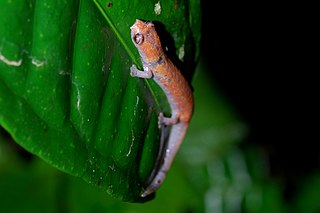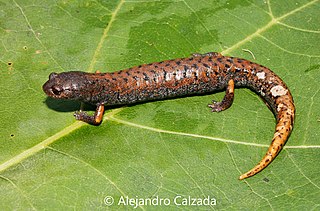
The arboreal salamander is a species of climbing salamander. An insectivore, it is native to California and Baja California, where it is primarily associated with oak and sycamore woodlands, and thick chaparral.

Taylor's salamander, Ambystoma taylori, is a species of salamander found only in Laguna Alchichica, a high-altitude crater lake to the southwest of Perote, Puebla, Mexico. It was first described in 1982 but had been known to science prior to that. It is a neotenic salamander, breeding while still in the larval state and not undergoing metamorphosis. The lake in which it lives is becoming increasingly saline and less suitable for the salamander, which is declining in numbers. The International Union for Conservation of Nature (IUCN) has rated it as being "critically endangered".

Hynobius yangi, the Kori salamander, is a species of salamander endemic to southeastern South Korea. It is a lentic-breeding species similar to the Korean salamander but is distinguished by factors including tail shape and dorsal coloration. The species is known from the vicinity of the type locality in Gijang County in northeastern Busan and from the nearby Ulju County in western Ulsan.

Nauta salamander, also known as the Nauta mushroomtongue salamander, is a species of salamander in the family Plethodontidae. It is found on the eastern and lower slopes of the Andes from Venezuela and Colombia through Ecuador and Peru to Bolivia and east into adjacent Brazil. Its common name refers to its type locality, Nauta, in the Loreto Province, Peruvian Amazon. It might a composite of several species.
Hartweg's climbing salamander, also known as Hartweg's mushroomtongue salamander, and Hartweg's salamander, is a species of salamander in the family Plethodontidae. It is found in the north-central Chiapas, Mexico, and the adjacent Guatemalan Sierra de los Cuchumatanes.
The Paramo Frontino salamander is a species of salamander in the family Plethodontidae. It is endemic to the Western Ranges of the Colombian Andes where it is known from the area of its type locality, Páramo Frontino. It is also known from the Colibri del Sol Bird Reserve near Urrao. both areas are in the Antioquia Department.
The graceful splayfoot salamander, also known as the graceful flat-footed salamander, is a species of salamander in the family Plethodontidae. It is endemic to the Tamaulipas state in northeastern Mexico. Its type locality is near Gómez Farías, Tamaulipas.
The Sierra Juarez hidden salamander, also known as the Sierra Juarez moss salamander, or simply Sierra Juarez salamander, is a species of salamander in the family Plethodontidae. It is endemic to the Caribbean slopes of the Sierra de Juarez and Sierra Mazateca, Oaxaca, Mexico.
Álvarez del Toro's hidden salamander, also known as Álvarez del Toro's salamander is a species of salamander in the family Plethodontidae. It is endemic to Mexico where it is known from its type locality near Jitotol as well as a nearby site on the Mexican Plateau in the Chiapas state.
Pseudoeurycea lineola, commonly known as the Veracruz worm salamander or Mexican slender salamander, is a species of salamander in the family Plethodontidae. It is endemic to the Sierra Madre Oriental near Cuautlapan, in the east-central Veracruz, Mexico, at elevations of 800–1,250 m (2,620–4,100 ft) above sea level. Molecular evidence suggests that it consists of two distinct species. It was the type species of genus Lineatriton.
Pseudoeurycea anitae, commonly known as Anita's false brook salamander or Anita's salamander, is a species of salamander in the family Plethodontidae. It is endemic to Mexico and only known from its type locality near San Vicente Lachixío, Oaxaca, in the Sierra Madre del Sur mountains, at about 2,100 m (6,900 ft) above sea level. The specific name anitae honors Anita Smith, a resident of Oaxaca City who helped Charles Mitchill Bogert when he was collecting in the surroundings of the city. This species might already be extinct.
Aquiloeurycea galeanae, commonly known as the Galeana false brook salamander, is a species of salamander in the family Plethodontidae. It is endemic to north-eastern Mexico and known from higher elevations in the Sierra Madre Oriental of southern Nuevo León as well as adjacent Coahuila and Tamaulipas.
Pseudoeurycea melanomolga, commonly known as the black false brook salamander or black salamander, is a species of salamander in the family Plethodontidae. It is endemic to Mexico and known from the surroundings of the Cofre de Perote in west-central Veracruz as well as from two localities in the adjacent northeast Puebla.

Pseudoeurycea mystax is a species of salamander in the family Plethodontidae. It is endemic to Mexico and only known from the area of its type locality near Ayutla, Oaxaca. Its common name is mustache false brook salamander or mustached false brook salamander. The specific name refers to the whitish protuberances on the lips that resemble a mustache in the frontal view of the male holotype.
Isthmura naucampatepetl, commonly known as the Cofre de Perote salamander, is a species of salamanders in the family Plethodontidae. It is endemic to the Sierra Madre Oriental in central Veracruz, Mexico, where it is known from between Cofre de Perote and Cerro Volcancillo, a satellite peak of Cofre de Perote.
Pseudoeurycea nigromaculata, commonly known as the black-spotted salamander or black-spotted false brook salamander is a species of salamander in the family Plethodontidae. It is endemic to Veracruz, Mexico, and known from Cerro Chicahuaxtla ) in Cuatlalpan and from Volcán San Martín at elevations of 1,200–1,300 m (3,900–4,300 ft). These separate populations likely represent distinct species.
Thorius arboreus, commonly known as the arboreal minute salamander, is a species of salamander in the family Plethodontidae. It is endemic to Sierra de Juarez, Oaxaca, Mexico. The specific name arboreus, derives from the Latin word arbor, meaning tree, referring to the arboreal habitat of this species.
Thorius aureus, the golden thorius, is a species of salamander in the genus Thorius, the Mexican pigmy salamanders, part of the lungless salamander family. It is endemic to mountainous areas of north central Oaxaca State in Mexico. It is one of the largest Thorius species.
Cornufer wuenscheorum is a species of frogs in the family Ceratobatrachidae. It is endemic to Yapen island in Indonesia, off the northern coast of New Guinea. The specific name wuenscheorum honours Rosi and Jochen Wünsche, friends of the scientist who described the species.






